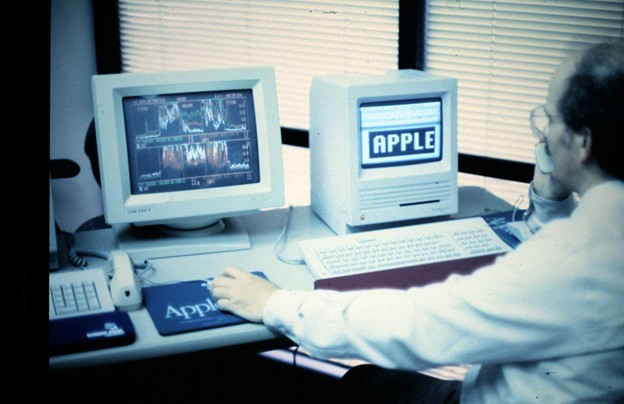About Us and Our History
ShadowMaker began long before the company existed. In 1978, one of the ShadowMaker co-founders, Violetta, co-founded her first company: Biofeedback Associates of California (BAC). BAC was a medical clinic based out of San Jose, California – the heart of the Silicon Valley. BAC used sEMG biofeedback to pioneer a revolutionary treatment protocol that she and the other co-founder, Dennis, dubbed Muscle Learning Therapy (MLT). They treated patients with work-related upper-extremity disorders (RSI repetitive strain injury, TMD temporomandibular joint disorder, CTS carpal tunnel syndrome, etc), chronic tension, stress reactivity, and rehabilitation from acute injuries – all using sEMG sensors.
The method was to detect tension (in the masseter, neck, upper trapezius, mid-back, lower back, glutes, forearms and wrists), give immediate feedback, and shape behavior through operant conditioning using progressively more complex tasks. BAC was retained by many local companies both to treat workplace injuries as well as to train uninjured workers preventively. These companies included Apple Computer, Hewlett-Packard, Chevron, the San Jose Police, the San Francisco 49ers, and many others. They had a 93% success rate at using sEMG biofeedback to reduce pain and improve quality of life for people with injuries (both static and chronic). BAC proved a core truth we still live by: physiology is trainable, and when you close the loop between body and feedback, people change.


The other ShadowMaker co-founder, Alexander, was introduced to sEMG biofeedback at Biofeedback Associates of California at a very young age – where he was trained by Violetta and Dennis in MLT to overcome his TMJ condition (aka “lockjaw”). He was successfully treated in a short time. He also learned how sEMG equipment was constructed, how to interpret sEMG graphs, how different placement geometries affected signal acquisition, and how to control his autonomic nervous system and his physiological responses… all by the age of 8!
Alexander went on to pioneer the design of the next generation of sEMG sensors in 2005 – a year before he graduated college in 2006. By 2008, he raised money to co-found Somaxis (a California C Corp), where he served as CTO and principal system architect. There, he designed, developed, and brought to market the “Cricket” wearable sensor. It was the first fully wireless, Bluetooth EXG (sEMG / ECG / EEG) sensor that was specifically designed to be noise resistant in high movement environments.
Somaxis translated the lesson that “physiology is trainable” into accessible, high-fidelity wearable sensors. The Cricket EXG line (and supporting firmware, software, and accessories) focused on the unglamorous problems that make or break electrophysiological biofeedback: signal quality, motion artifacts, comfort, and repeatability. Alexander engineered dynamic-gain front ends, created specially tuned filters, and came up with novel electrode placements, geometries, and materials to keep signals clean during real movement. All of these innovations collectively reduced multi-factor noise and enabled performance that didn’t just look good on a bench. It worked on people in dynamic environments – living their lives, working out, driving home, and taking care of their kids. His design was purchased and used by physical therapists, ergonomists, biofeedback therapists, researchers, and individuals around the world. Somaxis also created the legal and technical bridge that lets us carry proven EXG IP forward into ShadowMaker.
In 2012, he was invited to speak about this revolutionary technology and its applications on the TED stage in NYC.
Alexander authored 5 provisional patents for Somaxis, and then converted them to full utility patents. He oversaw the interactions with the USPTO, eventually getting all 5 approved – overcoming potentially conflicting patents by Motorola and other corporate giants in the process.
In 2015, Alexander spearheaded the integration of Cricket sEMG + IMU sensors into Bodymetrics, an exhibit hosted at The Tech Museum in San Jose, California. This exhibit combined EEG data from Emotiv with sEMG + IMU data from the Somaxis Cricket in order to create emotional state profiles of participants. Alexander donated the sEMG sensors to the Tech Museum in exchange for exclusive access to the complete database of biometric and affective state data that it produced. BodyMetrics ran for several years, producing the largest affective state database of its kind.
Somaxis eventually shifted to IP licensing as a model, and with no further products to develop in-house, Alexander left the company. He honed his skills on systems engineering, electronics engineering, DFM, vendor management, failure analysis, and material science. He worked for Sage Analytical Laboratories Inc doing IC-level and system-level Failure Analysis (FA) and reverse engineering. He then worked at General Atomics Aeronautical Systems Inc where he became a senior Failure Analysis Engineer (FAE aka FRACAS) and Army Avionics Team Lead for the Army’s UAV program, achieving 100% acceptance rate for 300+ avionics failure investigations and corrective actions over the course of 3+ years. He then was recruited by Blue Origin, where he was a Senior Materials & Processes Engineer and BE-4 Avionics Lead for 4+ years.
Alexander’s love for wearable sensors, big data, and emotional state analysis never waned. When the AI field started to grow, and problems started to emerge, he recognized a tremendous opportunity: one could combine wearable sensors, big data, emotional state analysis, and gaming in order to create AI with empathy. In 2020, Alexander and Violetta joined forces and together they incorporated ShadowMaker (a Washington C Corp). By 2025, prototype development was finally completed and Alexander started working full time at ShadowMaker Inc to prepare for launch.
Across all of this, one thread never breaks: evidence over hype. The clinics in the 1980s taught us to measure what matters and to keep the loop tight: detect, reflect, adapt. Somaxis taught us to engineer for the messy edge cases where devices usually fail. ShadowMaker fuses those lessons into a platform that lets AI systems read the room and act accordingly, with human psychophysiology in the loop and guardrails that respect context.
If the 1980s were about teaching humans to regulate themselves with better feedback, the 2020s must be about teaching AIs to regulate themselves better with better feedback. ShadowMaker stands on a family practice that measured first and promised later. We’re still doing exactly that. Only now, the interaction is between humans and AIs, and the outcome we’re optimizing is a world where powerful systems behave with emotional intelligence and ethical clarity.
